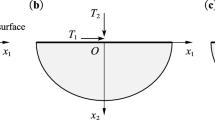Abstract
In this paper a pseudo-spectral method is proposed to solve a one-dimensional model of a saturated hard ferromagnetic thin-film structure within the Euler–Bernoulli kinematics. The model accounts for the non-local nature of the magneto-elastic coupling and interaction is in the form of a logarithmic potential. The proposed solution method adopts global polynomial interpolation at a main grid, given by the Gauss–Lobatto points, and it employs a secondary grid, consisting of the Gauss points, to perform the Gaussian quadrature. The two grids are non-overlapping to avoid the singularity. Interpolation relates the unknowns, evaluated at the secondary grid, to their values at the collocation grid. Furthermore, the integration interval is parted about the singularity point. The procedure is assessed through the relative equilibrium residual for different values of the approximating polynomial degree and of the quadrature order. Maximum, average and standard deviation of the error are presented. An asymptotic analysis yields the Boundary Solution to the problem and results are compared when the latter is introduced in the numerical scheme. It is shown that its contribution is important in reducing the overall error. The equilibrium residual is plotted and its behavior discussed. It is further shown that numerical precision significantly affects the results at midspan, owing to the self-equilibrium of the system, thereby a limit exists to the best accuracy which may be gained through a more accurate interpolation.









Similar content being viewed by others
Notes
It suffices to say that hard ferromagnets are generally treated through a constitutive equation which takes into account, beside the usual deformation gradient \({\mathbf{F} = \mathrm{grad} \,\varvec{\phi }}\), the local microstructure \({\varvec{M}}\) and its gradient \({\mathrm{grad} \,\varvec{M}}\). The former accounts for the anisotropy effect and the latter for the exchange forces.
In this section indexes, including vector rows and matrix rows and columns, range from zero.
References
Boyd JP (2000) Chebyshev and Fourier spectral methods, 2nd edn. Dover Publications, Inc, New York
Brown WF Jr (1966) Magnetoelastic interaction, tracts in natural philosophy, vol 9. Springer-Verlag, New York
Capriz G (1989) Continua with microstructure, springer tracts in natural philosophy, vol 35. Springer-Verlag, New York
Carman GP, Mitrovic M (1995) Nonlinear constitutive relations for magnetostrictive materials with applications to 1-d problems. J Intell Mater Syst Struct 6(5):673–683. doi:10.1177/1045389X9500600508
Funaro D (1992) Polynomial approximation of differential equations,lecture notes in physics, vol 8. Springer-Verlag, New York
Garbow BS, Hillstrom KE, More JJ (1980) MinPack project
Muskhelishvili NI (1992) Singular integral equations. Dover Publications, Inc., New York
Napoli G, Nobili A (2009) Mechanically induced Helfrich-Hurault effect in lamellar systems. Phys Rev E 80(031):710. doi:10.1103/PhysRevE.80.031710
Nobili A, Tarantino AM (2006) A hard ferromagnetic and elastic beam-plate sandwich structure. Zeitschrift für angewandte Mathematik und Physik (ZAMP) 57(4)
Nobili A, Tarantino AM (2008) Magnetostriction of a hard ferromagnetic and elastic thin-film structure. Math Mech Solids 13(2):95–123. Doi10.1177/1081286506073716. http://mms.sagepub.com/content/13/2/95.abstract, http://mms.sagepub.com/content/13/2/95.full.pdf+html
Pandolfi A, Napoli G (2011) A numerical investigation on configurational distortions in nematic liquid crystals. J Nonlinear Sci 21(5):785–809
Prez-Aparicio JL, Sosa H (2004) A continuum three-dimensional, fully coupled, dynamic, non-linear finite element formulation for magnetostrictive materials. Smart Mater Struct 13(3):493. http://stacks.iop.org/0964-1726/13/i=3/a=007
Tiersten HF (1994) Coupled magnetomechanical equations for magnetically saturated insulators. J Math Phys 5(9):1298–1318
Nobili A, Lanzoni L (2010) Electromechanical instability in layered materials. Mech Mat 42(5):581–591. doi:10.1016/j.mechmat.2010.02.006
Author information
Authors and Affiliations
Corresponding author
Rights and permissions
About this article
Cite this article
Nobili, A., Tarantino, A.M. Pseudo-spectral methods in one-dimensional magnetostriction. Meccanica 50, 99–108 (2015). https://doi.org/10.1007/s11012-014-0056-1
Received:
Accepted:
Published:
Issue Date:
DOI: https://doi.org/10.1007/s11012-014-0056-1




